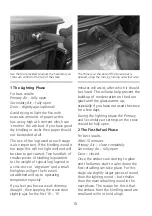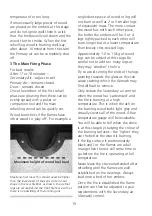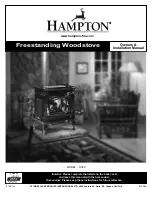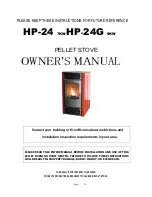
32
STOVE NOT PROVIDING
ENOUGH HEAT
This problem is also usually indicated
by dull orange lifeless flames and wood
that remains black when burning
instead of light grey. A flue temperature
gauge will provide you with the best
indication of whether or not your stove
is operating effectively.
• Causes: Poor fuel
Poor heat output
is more than likely caused by poor fuel,
such as ‘green’ or unseasoned wood.
We cannot over-estimate how critical
it is to use fully seasoned dry wood.
The easiest way to check whether your
wood is fully seasoned is to invest in a
moisture meter specifically designed for
testing wood fuel. These are relatively
inexpensive and can be purchased from
your stove dealer. When you bear in
mind that seasoned wood with a
moisture content of less than 20% will
give you approximately 50% more heat
than unseasoned wood, a moisture
meter is modest investment which will
more than pay for itself. See page 14
Unseasoned wood introduces
unwanted moisture into the fire-
chamber, reducing the stove’s operating
temperature and thus the effectiveness
of the air wash system. In addition it
will cause problems of increased soot
and harmful creosote deposits within
the flue system.
Softwoods such as Pine produce
significantly less heat output than
hardwoods.
• Causes: Air controls
Ensure that
you fully understand the difference that
using the Primary and Secondary air
controls make to the performance of
the stove and the best way to burn your
wood fuel. See pages 16 – 21
• Causes: Inadequate Combustion
Air
A stove starved of combustion air,
even when the Primary and Secondary
air controls are in the fully open
position, will provide limited heat
output. Check that any permanent
air vent fitted to supply the extra
combustion air required for the stove
has not been accidentally blocked.
Remember there should never be an
extractor fan in the same room as a
stove, even in a large open plan area.
A simple way of confirming whether
or not the stove is receiving enough
combustion air is to open a window
in the same room as the stove. If this
improves the problem then this would
certainly indicate that the stove is
being starved of combustion air and the
advice of the original installer should be
sought.
• Causes: Blockages
When safe to
do so, examine the flue-way above the
baffle plate as well as the flue pipe and
chimney system via the appropriate
inspection hatches and clear any soot
blockages. Excessive deposits could also
indicate that the chimney or flue itself
also needs cleaning. See page 34
GLASS STAINING OR BLACKENING
Glass can be cleaned easily if it is
undertaken regularly and the deposits
are not allowed to build up. A
proprietary stove glass spray or gel is
strongly recommended – see page 36.
Summary of Contents for HF217-SE Baby Gabriel
Page 2: ......
Page 7: ...7 GENERAL DIMENSIONS 414 435 555 95 134 345 134 125 ø All dimensions are in mm ...
Page 43: ......













































